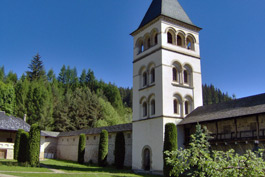Putna Monastery
Stephen the Great built the monastery  as his burial place between 1466 and 1469, and the Church of the Assumption of the Holy Virgin was consecrated one year later.
as his burial place between 1466 and 1469, and the Church of the Assumption of the Holy Virgin was consecrated one year later.
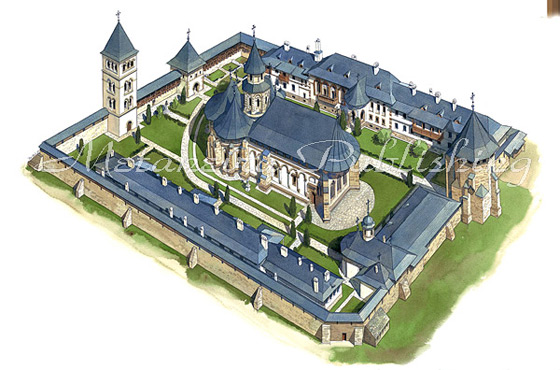
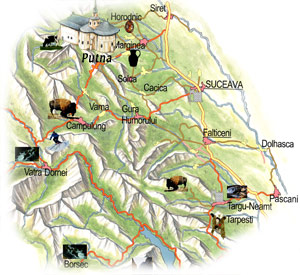
Year Built: 1466-1469
Built by: Stephen the Great
Location: Putna, Suceava County
Summary: The present church was practically rebuilt between 1653 and 1662 by Vasile Lupu and his successors.
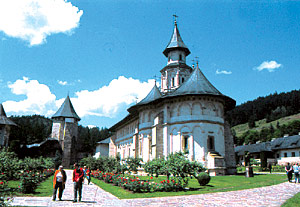
The imposing Putna Monastery is situated about 30 km northwest from the town of Radauti, near the Putna River. High, forested hills and wild landscape surround the monastery and the village with the same name.
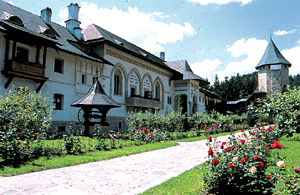
The first superior was Archimandrite Ioasaf from Neamt Monastery, the first important monastic centre in Moldavia. The superior was accompanied by calligraphers, who were the first teachers of the new monastery school that followed the example of the school of Neamţ. It started as a school of rhetoric, logic and grammar for future chroniclers and clerical staff, but soon Putna became one of the most significant cultural centres in the country.
Only three years after the monastery was completed, a fire destroyed it, but it was immediately rebuilt. It was destroyed again in 1653 by the Cossack army of Timuş Hmelniţchi, the son-in-law of Prince Vasile Lupu. The present church was practically rebuilt between 1653 and 1662 by Vasile Lupu and his successors. The ground plan follows the plan of the original edifice, as could be ascertained when the foundations of the first church were excavated from 1968 to 1970.

Stephen the Great ruled for half a century, 1457-1504. He earned his surname “Great” for his several successful military campaigns against the infidel Turks. He is also famous for building and influencing the building of dozens of churches and monasteries all over Moldavia. Allegedly he founded a religious edifice after each important military victory. In the Putna monastery, is found the tomb of king Stephen the Great and several of his family members. His tomb became a place of pilgrimage. The icon waves and the tomb covers are evidence of the creative spirit of the Moldavian artists of Stephen the Great’s time.

The church was unusually large for its time, but the explanation was that it was built to be the burial place of the Prince, his family and his successors. The thick walls are made of massive blocks of stone, and twelve buttresses support the walls. Originally there were only six, and the other six were added during the 17th and 18th centuries.
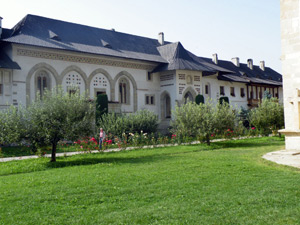
Although the present church follows the ground plan of a typical 15th and 16th century Moldavian church, it has many architectural and decorative features that are typical of 17th century churches. The exterior walls are not the smooth façades of earlier times, but two rows of blind arcades go around the building, smaller ones above the twisted stone cable, and tall ones below it.The stone cable motif was first used in the church of the Dragomirna Monastery in 1609.
The tall windows of the exonarthex, three on the west façade and one each on the north and south façades, follow the shape and size of the tall blind arcades. Their upper parts are decorated with intricately carved stone tracery. All the other windows are much smaller, with pointed arches and square carved stone frames. It had been usual to have only one window in each of the three apses, but here there are three windows in each apse, another late influence.
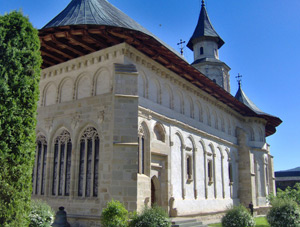
Also the lantern tower differs from the traditional ones: it is two-tiered. On the lower octagonal part, there is a small window on each side with a twisted Baroque pilaster in between them. On the upper, narrower part, there are the usual four windows.The entrance to the church goes through two lateral doors. Two groined vaults span the exonarthex, which is an unpainted room full of light from the five big windows. It is possible that the exonarthex was added to the construction later in the 17th century. Fragments of mural painting have been discovered on the east wall, but in areas that are no longer visible: under the present floor level and in the attic, behind the vaults.
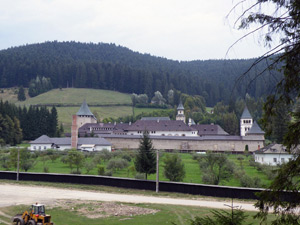
Putna is in the valley of the Putna River, 22km northwest of Radauti on DN 2H. In Radauti you can find accommodations and travel information. The town is 37 km northwest of Suceava, following E85 for 22km and then turning left on DN 2H for 15 km, on the plain between the Suceava and Sucevita Rivers. Suceava can be reached on the main European roads E85, E58, but also on the railway Bucharest-Chernivtsi-Lvov or by air. The city has an airport with flights to Bucharest and even abroad.
Contact:
Address: Putna, 727455, Suceava County
Phone: + 40 (230) 414055
